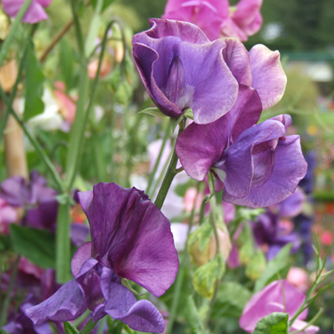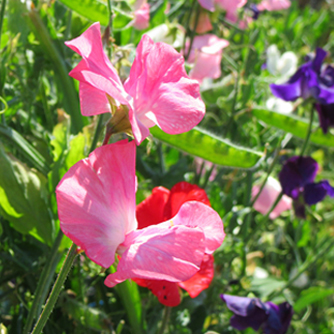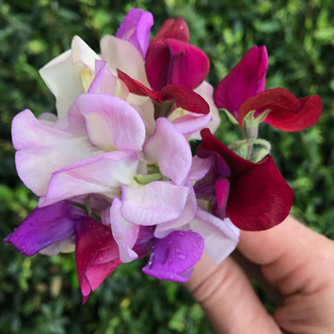Sweet Peas
BackSweet peas (Lathyrus odoratus) are a climbing annual with romantic ruffled flowers that make a perfect cut flower and are great in pots and containers. Many varieties produce a gorgeous perfume as well and all are easy to grow. What more could you want to brighten up your garden?
Sweet peas have been around for centuries and there are so many cultivars now it’s hard to keep track of them all. There are tall growing ones right down to dwarf sizes which look great in hanging baskets. Plus the flowers come in a choice of single colours, bicolour or speckled/striped. Unfortunately some varieties lack the classic sweet pea perfume so only purchase types which emphasize they have a strong perfume.
How To Grow Sweet Peas
The ideal position to grow sweet peas is full sun however they like to have ‘cool feet’. Many growers recommend planting other annuals such as primulas or pansies around the base of sweet peas to provide shade to their roots and keep them cooler.
Once you’ve chosen a spot improve the soil by digging in some compost and manure. Sweet peas love an alkaline soil (7-8 pH is perfect) so also apply lime or dolomite to raise the alkalinity of your soil. Taller varieties will need some kind of support (eg trellis or wire) as they grow and it’s best to install that at planting time.

The charming sweet pea in flower
Sweet peas are usually grown from seed and sown directly into the soil. Some seeds will be small and shriveled but it’s important to plant even the “bad” looking ones as they can often be the darker colours. Plant seeds into damp soil to a depth of about 3cm and water in with OCP eco-seaweed. Mulch well using an organic sugar cane mulch. Sweet pea seeds are vulnerable to rotting so do not water again until the young shoots break through the soil (unless you have especially hot and dry weather). Germination usually takes 7-15 days.
If you want to speed things up you can soak the seeds overnight in a bowl of warm water. Seeds will absorb some moisture and start the germination process a bit quicker.
Sowing Guide for Sweet Peas
| Growing Zone | Sowing Time |
| Cool Zones | Autumn, Winter, Spring |
| Mediterranean Zones | Autumn, Winter |
| Warm & Temperate Frost Free Zones | Autumn, Winter |
| Subtropical Zones | Autumn, Winter (Dry Season) |
| Tropical Zones | Not recommended |

Sweet peas growing beautifully along a sunny front fence
Sweet peas are a cool season plant and seeds germinate fastest when soils have cooled down (under 20 degrees) but before they get really cold (ie winter). This means autumn is the best time to sow seed. Traditionally St Patrick’s Day (17th March) has been the day to plant but with the changing climate soils are often still too warm then. We suggest using Anzac Day (25th April) as a better date now.
In cold regions winter sowings often fail because the seed takes longer to germinate and gets over watered and rots. Heavy frosts can also damage young seedlings and flowers.
Hot spring and summer weather promotes stress in the plants and shortens their lifespan. Only areas with mild summers can get away with sowing in spring and still have a good showing.
Fertilising and Maintenance of Sweet Peas
As plants grow apply a mixture of OCP eco-seaweed and OCP eco-aminogro every 2-3 weeks to encourage maximum growth and flowering. Pinch out the tips of early growth on small plants once or twice to encourages denser growth and more flowers later on. As they approach flowering size they’ll appreciate a second application of lime or dolomite to the soil.
Regularly deadhead finished flowers so energy goes into more flower buds instead of seed pods. Cut flowers are best picked in the morning when freshest. Use scissors or secateurs to prevent tearing the main stems.

Sweet peas with developing seed pods in the background
Towards the end of the growing season let some seed pods fully develop so you’ll have seeds for next year. Harvest when pods are fully dry and store in a dry, dark place until you’re ready to sow again.
Pest and Disease Problems of Sweet Peas
Common problems include:
- Snails and slugs like to munch on tender seedlings so apply some OCP eco-shield pellets to keep them protected.
- failure to germinate can be due to the soil being too warm or excess watering before seed germinates. Only sow seed once there is a distinct and permanent change of season (when mornings have that chill in the air) and resist the urge to water the soil until the shoots poke through.
- Powdery mildew is incredibly common in sweet peas especially when temperatures start to warm up. Spray with an organic fungicide at the first sign of trouble and repeat as required. Ultimately these annual plants will usually die from powdery mildew so spraying is about trying to delay this for as long as possible to be able to enjoy more flowers.
- Aphids and mites – if either of these sap sucking pests appear spray with OCP eco-oil or OCP eco-neem for easy control.

A posey of sweet peas make great cut flowers


